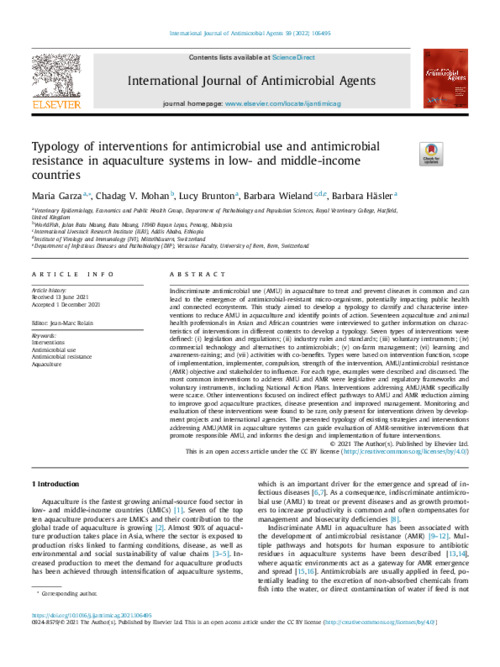Typology of interventions for antimicrobial use and antimicrobial resistance in aquaculture systems in low- and middle-income countries

Indiscriminate antimicrobial use (AMU) in aquaculture to treat and prevent diseases is common and can lead to the emergence of antimicrobial-resistant micro-organisms, potentially impacting public health and connected ecosystems. This study aimed to develop a typology to classify and characterise interventions to reduce AMU in aquaculture and identify points of action. Seventeen aquaculture and animal health professionals in Asian and African countries were interviewed to gather information on characteristics of interventions in different contexts to develop a typology. Seven types of interventions were defined: (i) legislation and regulations; (ii) industry rules and standards; (iii) voluntary instruments; (iv) commercial technology and alternatives to antimicrobials; (v) on-farm management; (vi) learning and awareness-raising; and (vii) activities with co-benefits. Types were based on intervention function, scope of implementation, implementer, compulsion, strength of the intervention, AMU/antimicrobial resistance (AMR) objective and stakeholder to influence. For each type, examples were described and discussed. The most common interventions to address AMU and AMR were legislative and regulatory frameworks and voluntary instruments, including National Action Plans. Interventions addressing AMU/AMR specifically were scarce. Other interventions focused on indirect effect pathways to AMU and AMR reduction aiming to improve good aquaculture practices, disease prevention and improved management. Monitoring and evaluation of these interventions were found to be rare, only present for interventions driven by development projects and international agencies. The presented typology of existing strategies and interventions addressing AMU/AMR in aquaculture systems can guide evaluation of AMR-sensitive interventions that promote responsible AMU, and informs the design and implementation of future interventions.
Permalink
Date Available
Type
Publisher
Countries
ISSN
0924-8579
Copyright
CC-BY-4.0
Research Themes
Language